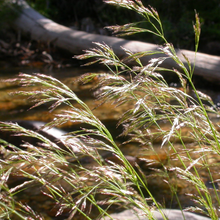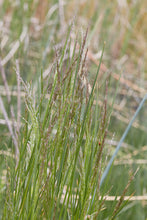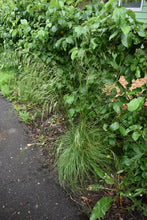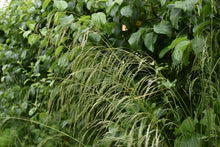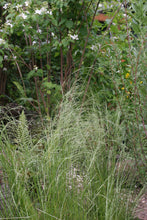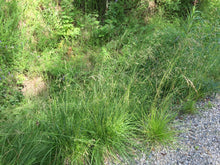
Deschampsia cespitosa
Tufted hairgrass is a large, long-lived perennial bunchgrass that provides dense, bright green tufts of foliage to open, sunny garden areas. In early summer, it shoots up stems with iridescent, shimmering inflorescence that start out purple-ish and graduate to tan and tawny hues. These fountain-like inflorescence dance and sway up to a meter above the foliage and are quite ornamental. Like most native grasses, a patch of tufted hairgrass provides excellent habitat for countless species of arthropods and the late-season seed heads bring birds to the garden.
- Plant type/canopy layer: deciduous, perennial, grass
- Size at maturity: 24"-36" tall, 12"-24" wide
- Light requirements: full sun
- Moisture requirements: moist to wet soil
- Bloom Time: n/a
- Growth rate/ease: moderate growth rate, easy to grow
- Wildlife support: seeds provide food for birds; overall plant provides excellent habitat for arthropods, is eaten by bears and deer, and is a caterpillar host and larval food source for some species of native moths and butterflies such as the Juba Skipper
- Native habitat/range: commonly found in wet prairies, wet meadows, along stream banks, open areas surrounding lakes and salt marshes, from sea level to about 3000m, across Oregon and most of the country, except the southeastern US, into Canada and other circumboreal regions of the world. Portland Plant List - yes.
- Special features & uses: First Nations people report to have traditionally eaten the seeds; landscape uses include meadowscapes, raingardens, bioswales and erosion control
Gardening with Tufted Hairgrass: Tufted hairgrass strongly prefers open, sunny areas and is almost never found under tree or shrub canopy. As for soil, be sure it has moist to wet, acidic soils - and even tolerates salty and flooded conditions. It thrives in the cool-season and survives the summer drought by mostly dying back, leaving excellent arthropod habitat. The seemingly spent brown tufts will reinvigorate when temperatures drop and fall rains return. Plant this attractive species to give structure to your open wet meadow areas - interplanted with other moist sun loving wildflowers.
Photo Credit 1 (inflorescence closeup): "Deschampsia cespitosa" by Matt Lavin is licensed under CC BY-SA 2.0.
Photo Credit 2 (inflorescence): © Ken-ichi Ueda, some rights reserved (CC-BY)
Photo Credits 3 & 4 (along sidewalk, inflorescence in the garden): Nikkie West, Sparrowhawk Native Plants
Photo Credit 5 (in the habitat garden): Karli Del Biondo, Beetles and Bees
Photo Credit 6 (in the wild): © Jason Grant, some rights reserved (CC-BY)






